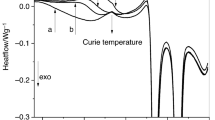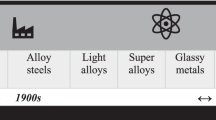Abstract
Mechanical alloying (MA) pioneered by Benjamin is a technique for the extension of solid solubility in systems where the equilibrium solid solubility is limited. This technique has, in recent years, emerged as a novel alternate route for rapid solidification processing (RSP) for the production of metastable crystalline, quasicrystalline, amorphous phases and nanocrystalline materials. The glass-forming composition range (GFR), in general, is found to be much wider in case of MA in comparison with RSP. The amorphous powders produced by MA can be compacted to bulk shapes and sizes and can be used as precursors to obtain high strength materials. This paper reports the work done on solid state amorphization by MA in Ti-Ni-Cu and Al-Ti systems where a wide GFR has been obtained. Al-Ti is a classic case where no glass formation has been observed by RSP, while a GFR of 25–90 at.% Ti has been obtained in this system, thus demonstrating the superiority of MA over RSP. The free energy calculations made to explain GFR are also presented.
Similar content being viewed by others
References
Atzmon M, Unruh K M and Johnson W L 1985J. Appl. Phys. 58 3865
Bakker H 1985J. Less Common Metals 105 129
Benjamin J S 1976Sci. Am. 234 40
Bonetti E, Cocco G, Enzo S and Valde G 1990Mater. Sci. Tech. 6 1258
Cocco G, Soletta I, Battezzati L, Baricco M and Enzo S 1980Philos. Mag. B61 473
Eckert J, Schultz L and Urban K 1991Mater. Sci. Engg. A133 393
Egami T and Waseda Y 1984J. Non-Cryst. Solids 64 113
El-Eskandarany M S, Itoh F, Aoki K and Suzuki R 1990J. Non-Cryst. Solids 117/118 729
Eshelby J D 1956Solid State Phys. 3 79
Fecht H J, Han G, Fu Z and Johnson W L 1990J. Appl. Phys. 67 1744
Friedel J 1964Dislocations (Oxford: Pergamon) p. 418
Gallego L J, Somoga J A and Alonso J A 1990J. Phys. Condensed Matter 2 6245
Gilman P S and Benjamin J S 1983Ann. Rev. Mater. Sci. 13 279
Guo W, Martelli S, Burgio N, Magini M, Padella F, Paradiso E and Soletta I 1991J. Mater. Sci. 26 6190
Highmore R J, Evetts J E, Greer A L and Somekh R E 1987Appl. Phys. Lett. 50 566
Hori S, Tai H and Narita Y 1985Proc. rapidly quenched metals V, (eds) S Steeb and H Warlimont (Amsterdam: Elsevier) pp 911
Johnson W L 1986Prog. Mater. Sci. 30 81
Koch C C 1989Ann. Rev. Mater. Sci. 19 121
Koch C C, Cavin O B, Mc Kamey C G and Scorbrough J O 1983Appl. Phys. Lett. 43 1017
Lee P Y and Koch C C 1987J. Non-Cryst. Solids 94 88
Lee P Y, Jang J and Koch C C 1988J. Less Common Metals 140 73
Massalski T B and Woychik C G 1985Acta Metall. 33 1873
Matsuki K, Inoue A, Kimura H M and Masumoto T 1988Mater. Sci. Engg. 97 47
Miedema A R, de Chatel P F and de Boer F R 1980Physica B100 1
Murray J L 1988Metall. Trans. A19 243
Murty B S, Ranganathan S and Mohan Rao M 1989Proc. of the Indo-US workshop on metastable microstructures, Goa (in press)
Murty B S, Mohan Rao M and Ranganathan S 1990Scr. Metall. 24 1819
Murty B S, Ranganathan S and Mohan Rao M 1992Mater. Sci. Engg. A149 231
Niessen A K, de Boer F R, Boom R, de Chattel P F, Mattena W C H and Miedema A R 1983Calphad 7 52
Oehring M and Bormann R 1991Mater. Sci. Engg. A134 1330
Pearson W B 1974Handbook of lattice spacings and structures of metals and alloys, (Oxford: Pergamon)
Politis C and Johnson W L 1986J. Appl. Phys. 60 1147
Schultz L 1988Mater. Sci. Engg. 97 15
Schulz R, Trudeau M L and Van Neste A 1991Mater. Sci. Engg. A134 1354
Schwarz R B and Johnson W L 1983Phys. Rev. Lett. 51 415
Schwarz R B and Koch C C 1986Appl. Phys. Lett. 49 146
Schwarz R B, Petrich R R and Saw C K 1985J. Non-Cryst. Solids 76 281
Schwarz R B, Nash P and Turnbull D 1987J. Mater. Res. 2 456
Simozar S and Alonso J A 1984Phys. Status Solidi A81 55
Smithells C J 1983Metals reference book (London: Buttersworth) p. 13–10 13– 56
Sundaresan R and Froes F H 1987J. Metals 39 22
Sundaresan R, Jackson A G, Krishna Murthy S and Froes F H 1988Mater. Sci. Engg. 97 115
Suryanarayana C and Froes F H 1991Proc. INCAL-91 (eds) E S Dwarakadasa, S Seshan and K P Abraham, p. 593
Uenishi K, Kobayashi K F, Ishihara K N and Shingu P M 1991Mater. Sci. Engg. A134 1342
Van der Kolk C J, Miedema A R and Niessen A K 1988J. Less Common Metals 145 1
Veltl G, Scholz B and Kunze H D 1991Mater. Sci. Engg. A134 987
Weeber A W 1987J. Phys. F: Met. Phys. 17 809
Weeber A W and Bakker H 1988Physica B153 93
Willey L A and Margolin H 1973Metals Handbook (Metals Park, Ohio: ASM) p. 264
Author information
Authors and Affiliations
Rights and permissions
About this article
Cite this article
Murty, B.S. Mechanical alloying—a novel synthesis route for amorphous phases. Bull. Mater. Sci. 16, 1–17 (1993). https://doi.org/10.1007/BF02745302
Received:
Issue Date:
DOI: https://doi.org/10.1007/BF02745302




